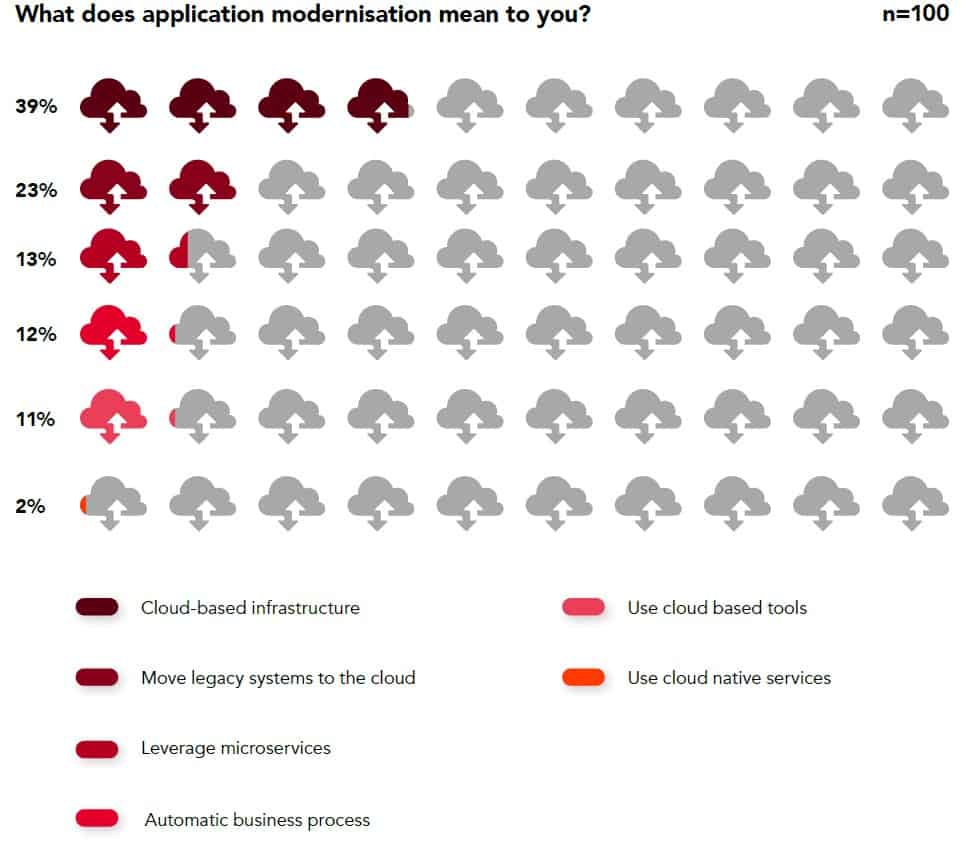For years now, companies worldwide have been engaged in an uphill battle to modernise their IT applications to meet agility requirements in various areas of operations, marketing and customer engagement.
Application modernisation is a linchpin of an enterprise’s digital transformation journey, particularly in Asian countries like China, India and Japan in the wake of customer demand for real-time and more interactive online services.
Gartner describes the process as “the migration of legacy to new applications or platforms, including the integration of new functionality to provide the latest functions to the business”. Modernisation options include re-platforming, re-hosting, recoding, rearchitecting, re-engineering, interoperability, replacement, and retirement, as well as changes to the application architecture to clarify which option should be selected.
Legacy systems are a fixture in every industry – never more so in verticals such as the financial and services sector, which is notorious for running decades-old systems in the back office. Indeed, legacy systems continue to run mission-critical business processes in most organisations.
A recent survey indicates over two-thirds of businesses still use mainframe or legacy apps for core business operations, and more than 60% rely on them to power customer-facing applications. The same survey revealed 70% of global CXOs see legacy modernisation as a top business priority.
Hong Kong, as a well-established business commercial hub in Asia Pacific, has been at the forefront of digitisation that enables the city to keep its competitive edge. By the same token, however, the city’s heavy reliance on technology means many organisations in Hong Kong have their core business processes on old systems long in need of a refresh.
To determine the current state of application modernisation among Hong Kong enterprises, FutureCIO, on behalf of Red Hat, conducted a three-part survey of senior business and technology executives for insights into the challenges and drivers that spur their decision to reupholster applications to meet agility demands of the digital era.
Cloud reigns supreme
As cloud technology continues to mature and becomes mainstream, it is now an essential component of an organisation’s technology stack.
This reality is reflected by survey results which showed 39% of responses citing that the requirements of a cloud-based infrastructure means applications are built specifically to maximise the value of the new environment.
Figure 1: What does application modernisation mean to you? (Select all that apply) (n=102)

Source: FutureCIO, Cxociety, Red Hat 2022
Simply rehosting applications in the cloud will likely cut some costs and solve some technical debt issues. But to truly reap the benefits of the cloud, companies must modernise their application for the new platform.
Meanwhile, nearly a quarter or 24% of responses said migrating legacy systems to the cloud is a trigger for application modernisation.
The transition of legacy systems onto newer platforms is typically precipitated by several factors ranging from increased regulation, client demand for transparency, real-time reporting, and the ability to support and take advantage of new growth opportunities. These factors have all put increased pressure on 30- or 40-year-old systems that were not designed to cope with such challenges.
Legacy systems also have more significant cost implications the longer they are used, with increased IT spending being budgeted toward simply keeping them up as opposed to innovating.
Nevertheless, these systems are key strategic assets that were built over time – delivering significant business value to organisations. By moving them to the cloud, companies are able to continue extracting value out of legacy systems while planning for a future in which they could remain for quite some time.
For one, cloud migration may be an ideal strategy if an organisation is seeking to reduce its rack and server room space since maintaining and upgrading old hardware and operating systems in-house is challenging and expensive.
Meanwhile, Hong Kong companies embrace application modernisation as a natural consequence of deploying microservices, with 13% of survey responses equating this contemporary approach to application development as responsible for the rise of agile applications.
Microservices allow a large application to be built from modular components or services. Each module supports a specific task or business goal and uses a simple, well-defined interface, such as an application programming interface (API), to communicate with other sets of services.
This means an enterprise application is modernised by having developers reorganise it into a microservices architecture. This separates the application’s feature sets into microservices that can scale independently from one another. For example, an e-commerce store might need to scale up the transaction processing service independently from the quotation service during peak sales times.
Again, cloud technology – with its capabilities to scale resources dynamically based on what’s needed – makes it the natural home for microservices.
Changes, fixes and updates on microservices can also now be done incrementally, in some cases during the middle of a business day, instead of updating the complete application.
It is now quite common to see applications running in the cloud as if they were simply “lifted and shifted” there, with some components or feature sets being implemented as microservices. This is a more gradual approach, but it works for many applications and offsets the cost and time problem, as components are modernised in a phased manner.





